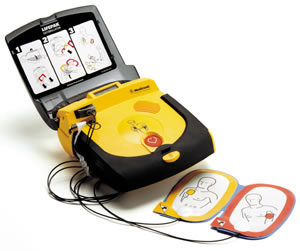Perhaps, you have seen an AED in your workplace or in the subway or at the fitness center. AEDs can be found almost everywhere. But many people still don’t know what AED stands for.
Well, AED means Automated External Defibrillator.
AEDs are especially designed to provide electrical shock to the heart, so that the heart resumes normal heartbeat. The AED is capable of analyzing the heart’s rhythm. Based on the rhythm, it states whether to give a shock, and then charges. It then prompts the operator to push the button to deliver the shock.
AEDs can recognize two life-threatening heart rhythms – ventricular tachycardia and ventricular fibrillation. Both conditions are characterized by uncoordinated electrical impulses of the heart that ultimately result in the heart’s inability to get enough oxygen and inability to pump out enough oxygen to the brain. There is actually no blood circulation.
When the AED recognizes any of these abnormal heart rhythms, it will charge and instruct the operator to give a shock. The electrical shock causes the chaotic and abnormally fast electrical activity to stop, allowing the heart to reorganize and return to normal heart rhythm, pumping, and distributing sufficient amounts of oxygenated blood. The longer it is for the heart to have no adequate circulation of oxygenated blood, the more damage the heart tissues become. If left untreated, the electrical activity eventually stops resulting in asystole or cardiac arrest.
Every minute that passes without defibrillation decreases the chance of survival by 10 percent. The success rate of resuscitation for an individual who has had no circulation, no breathing, and no CPR for more than 10 minutes is very slim. Early defibrillation can increase the survival rate by more than 50 percent.
First responders should provide initial chest compressions immediately and use the AED as soon as possible.
Some important things to consider before using AED:
- Be sure the patient is not in standing water before using AED. Also, make sure the patient is not in contact with any metal surface.
- If the patient has a pacemaker, slightly adjust the placement of the pad so that it does not cover the device. Remove medication patches on the chest before applying the pad. However, be sure to use gloves or avoid touching the inside surface.
- Never turn off the device or remove the pads.
Here is a guide on how to use the AED:
Turn the AED on.
- Expose the chest. If the chest is wet, dry it off first. You may need to shave off think hair.
- Apply one pad over the upper right chest just above the nipple; the other pad on the lower left ribs slightly below the armpit.
- Press the pads firmly.
- Follow the instructions on the AED.
- Stand clear. Make sure you do not touch the patient while the AED is analyzing the heart rhythm.
- If the AED displays, “Shock advised, charging,” instruct everyone to stay away from the patient by shouting “Clear.” Make sure no one is in contact with the victim. Push the button to provide shock.
- If the AED does not advise shock, continue with CPR if the patient remains unconscious and not breathing.
- After delivering shock, give 30 chest compressions then 2 breaths. Continue with a cycle of 30:2 until there is spontaneous breathing, pulse and signs of life.
The AED automatically reanalyzes every 2 minutes. Shock may be advised.
 Turn the AED on.
Turn the AED on.